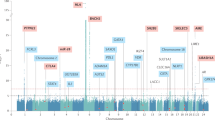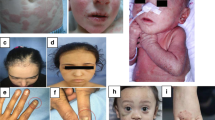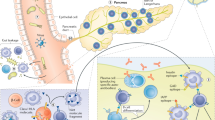Abstract
The autoimmune polyglandular syndromes—a group of syndromes comprising a combination of endocrine and nonendocrine autoimmune diseases—differ in their component diseases and in the immunologic features of their pathogenesis. One of the three main syndromes, type 1 autoimmune polyglandular syndrome (APS-1), has a unique pathogenic mechanism owing to mutations in the autoimmune regulator (AIRE) gene, which results in the loss of central tolerance—a process by which developing T cells with potential reactivity for self-antigens are eliminated during early differentiation in the thymus. Patients with IPEX (immune dysfunction, polyendocrinopathy, enteropathy, X-linked) syndrome harbor mutations in the forkhead box P3 (FOXP3) gene in regulatory T cells, which leads to severe autoimmunity and immune deficiency. Although both of these disorders are rare, their well-defined mechanisms of disease provide a basis for the understanding of the more common condition, APS-2. In this syndrome, alleles of human leukocyte antigens (HLAs) determine the targeting of specific tissues by autoreactive T cells, which leads to organ-specific autoimmunity as a result of this loss of tolerance. Non-HLA genes also contribute to autoimmunity in APS-2 and, depending on the polymorphism, potentially predispose to a loss of tolerance or influence which organ is specifically targeted. This Review discusses the genetic basis of APS-1, APS-2 and IPEX syndrome, with an emphasis on the mechanisms of autoimmunity and presents currently available therapies to treat their underlying autoimmune disorders.
Key Points
-
The type 1 autoimmune polyglandular syndrome results from mutations in the AIRE gene, which modulates transcription of peripheral self-antigens in the thymus presented by human leukocyte antigen (HLA) molecules to maturing T cells
-
The type 2 autoimmune polyglandular syndrome is the most frequent autoimmune polyglandular syndrome, with underlying pathologies that develop years to decades apart in an affected individual
-
Patients with Addison disease have a 50% risk of developing a second autoimmune disease during their lifetime
-
Mutations in HLA genes, which encode the MHC (major histocompatibility complex) class II molecules expressed by antigen-presenting cells, contribute to the targeting of specific tissues by autoreactive T cells
-
Non-HLA genes contribute to the risk of autoimmune disease, as they may reduce the threshold of autoimmunity or influence the organs affected in type 2 autoimmune polyglandular syndrome
-
IPEX (immune dysfunction, polyendocrinopathy, enteropathy, X-linked) syndrome results from mutations in the forkhead box protein P3 (FOXP3) gene, which is necessary for normal function of regulatory T cells
This is a preview of subscription content, access via your institution
Access options
Subscribe to this journal
Receive 12 print issues and online access
$209.00 per year
only $17.42 per issue
Buy this article
- Purchase on Springer Link
- Instant access to full article PDF
Prices may be subject to local taxes which are calculated during checkout


Similar content being viewed by others
References
Michels, A. W. & Eisenbarth, G. S. Autoimmune polyendocrine syndrome type 1 (APS-1) as a model for understanding autoimmune polyendocrine syndrome type 2 (APS-2). J. Intern. Med. 265, 530–540 (2009).
Friedman, T. C. et al. Frequent occurrence of asplenism and cholelithiasis in patients with autoimmune polyglandular disease type I. Am. J. Med. 91, 625–630 (1991).
The Finnish-German APECED Consortium. An autoimmune disease, APECED, caused by mutations in a novel gene featuring two PHD-type zinc-finger domains. Nat. Genet. 17, 399–403 (1997).
Anderson, M. S. et al. Projection of an immunological self shadow within the thymus by the aire protein. Science 298, 1395–1401 (2002).
Gardner, J. M. et al. Deletional tolerance mediated by extrathymic Aire-expressing cells. Science 321, 843–847 (2008).
Fan, Y. et al. Thymus-specific deletion of insulin induces autoimmune diabetes. EMBO J. 28, 2812–2824 (2009).
Kyewski, B., Derbinski, J., Gotter, J. & Klein, L. Promiscuous gene expression and central T-cell tolerance: more than meets the eye. Trends Immunol. 23, 364–371 (2002).
Kumar, P. G., Laloraya, M. & She, J. X. Population genetics and functions of the autoimmune regulator (AIRE). Endocrinol. Metab. Clin. North Am. 31, 321–338 (2002).
Su, M. A. et al. Mechanisms of an autoimmunity syndrome in mice caused by a dominant mutation in Aire. J. Clin. Invest. 118, 1712–1726 (2008).
Su, M. A. & Anderson, M. S. Aire: an update. Curr. Opin. Immunol. 16, 746–752 (2004).
Halonen, M. et al. AIRE mutations and human leukocyte antigen genotypes as determinants of the autoimmune polyendocrinopathy-candidiasis-ectodermal dystrophy phenotype. J. Clin. Endocrinol. Metab. 87, 2568–2574 (2002).
Ramsey, C. et al. Aire deficient mice develop multiple features of APECED phenotype and show altered immune response. Hum. Mol. Genet. 11, 397–409 (2002).
Meyer, G. et al. Screening for an AIRE-1 mutation in patients with Addison's disease, type 1 diabetes, Graves' disease and Hashimoto's thyroiditis as well as in APECED syndrome. Clin. Endocrinol. (Oxf.) 54, 335–338 (2001).
Meager, A. et al. Anti-Interferon Autoantibodies in autoimmune polyendocrinopathy syndrome type 1. PLoS Med. 3, e289 (2006).
Meloni, A. et al. Autoantibodies against type I interferons as an additional diagnostic criterion for autoimmune polyendocrine syndrome type I. J. Clin. Endocrinol. Metab. 93, 4389–4397 (2008).
Cervato, S. et al. Evaluation of the autoimmune regulator (AIRE) gene mutations in a cohort of Italian patients with autoimmune-polyendocrinopathy-candidiasis-ectodermal-dystrophy (APECED) and in their relatives. Clin. Endocrinol. (Oxf.) 70, 421–428 (2009).
Perheentupa, J. in Autoimmune Polyendocrine Syndromes (ed. Eisenbarth, G. S.) 295–320 (W. B. Saunders Company, Philadelphia, 2002).
Wenzlau, J. M. et al. The cation efflux transporter ZnT8 (Slc30A8) is a major autoantigen in human type 1 diabetes. Proc. Natl Acad. Sci. USA 104, 17040–17045 (2007).
Lieberman, S. M. & DiLorenzo, T. P. A comprehensive guide to antibody and T-cell responses in type 1 diabetes. Tissue Antigens 62, 359–377 (2003).
Eisenbarth, G. S., Wilson, P. W., Ward, F., Buckley, C. & Lebovitz, H. E. The polyglandular failure syndrome: disease inheritance, HLA- type and immune function. Ann. Intern. Med. 91, 528–533 (1979).
Klein, J. & Sato, A. The HLA system. First of two parts. N. Engl. J. Med. 343, 702–709 (2000).
Klein, J. & Sato, A. The HLA system. Second of two parts. N. Engl. J. Med. 343, 782–786 (2000).
Kwon, O. J. et al. Immunogenetics of HLA class II in Israeli Ashkenazi Jewish, Israeli non-Ashkenazi Jewish, and in Israeli Arab IDDM patients. Hum. Immunol. 62, 85–91 (2001).
Undlien, D. E., Lie, B. A. & Thorsby, E. HLA complex genes in type 1 diabetes and other autoimmune diseases. Which genes are involved? Trends Genet. 17, 93–100 (2001).
Eisenbarth, G. S. & Gottlieb, P. A. Autoimmune polyendocrine syndromes. N. Engl. J. Med. 350, 2068–2079 (2004).
Maclaren, N. K. & Riley, W. J. Inherited susceptibility to autoimmune Addison's disease is linked to human leukocyte antigens-DR3 and/or DR4, except when associated with type 1 autoimmune polyglandular syndrome. J. Clin. Endocrinol. Metab. 62, 455–459 (1986).
Betterle, C. et al. The natural history of adrenal function in autoimmune patients with adrenal autoantibodies. J. Endocrinol. 117, 467–475 (1988).
Betterle, C. et al. I. Adrenal cortex and steroid 21-hydroxylase autoantibodies in adult patients with organ-specific autoimmune diseases: markers of low progression to clinical Addison's disease. J. Clin. Endocrinol. Metab. 82, 932–938 (1997).
Betterle, C. et al. II. Adrenal cortex and steroid 21-hydroxylase autoantibodies in children with organ-specific autoimmune diseases: markers of high progression to clinical Addison's disease. J. Clin. Endocrinol. Metab. 82, 939–942 (1997).
Falorni, A. et al. 21-hydroxylase autoantibodies in adult patients with endocrine autoimmune diseases are highly specific for Addison's disease. Clin. Exp. Immunol. 107, 341–346 (1997).
Yu, L. et al. DRB1*04 and DQ alleles: expression of 21-hydroxylase autoantibodies and risk of progression to Addison's disease. J. Clin. Endocrinol. Metab. 84, 328–335 (1999).
Liu, E., Yu, L., Moriyama, H. & Eisenbarth, G. S. Animal models of insulin-dependent diabetes. Methods Mol. Med. 102, 195–212 (2004).
Lord, C. J. et al. The murine type 1 diabetes loci, Idd1, Idd3, Idd5, Idd9, and Idd17/10/18, do not control thymic CD4-CD8-/TCRαβ+ deficiency in the nonobese diabetic mouse. Mamm. Genome 12, 175–176 (2001).
Moriyama, H. et al. Induction and acceleration of insulitis/diabetes in mice with a viral mimic (polyinosinic-polycytidylic acid) and an insulin self-peptide. Proc. Natl Acad. Sci. USA 99, 5539–5544 (2002).
Nakayama, M. et al. Prime role for an insulin epitope in the development of type 1 diabetes in NOD mice. Nature 435, 220–223 (2005).
Nakayama, M. et al. Priming and effector dependence on insulin B:9–23 peptide in NOD islet autoimmunity. J. Clin. Invest. 117, 1835–1843 (2007).
Amrani, A. et al. Progression of autoimmune diabetes driven by avidity maturation of a T-cell population. Nature 406, 739–742 (2000).
Hutton, J. C. & Eisenbarth, G. S. A pancreatic β-cell-specific homolog of glucose-6-phosphatase emerges as a major target of cell-mediated autoimmunity in diabetes. Proc. Natl Acad. Sci. USA 100, 8626–8628 (2003).
Lieberman, S. M. et al. Identification of the β cell antigen targeted by a prevalent population of pathogenic CD8+ T cells in autoimmune diabetes. Proc. Natl Acad. Sci. USA 100, 8384–8388 (2003).
Gottlieb, P. A. & Rossini, A. A. in Autoimmune Disease Models: A Guidebook (eds Cohen, I. R. & Miller, A.) 163–174 (Academic Press, 1994).
Martin, A. M. et al. Diabetes-prone and diabetes-resistant BB rats share a common major diabetes susceptibility locus, iddm4: additional evidence for a “universal autoimmunity locus” on rat chromosome 4. Diabetes 48, 2138–2144 (1999).
Hornum, L., Romer, J. & Markholst, H. The diabetes-prone BB rat carries a frameshift mutation in Ian4, a positional candidate of Iddm1. Diabetes 51, 1972–1979 (2002).
MacMurray, A. J. et al. Lymphopenia in the BB rat model of type 1 diabetes is due to a mutation in a novel immune-associated nucleotide (ian)-related gene. Genome Res. 12, 1029–1039 (2002).
Awata, T., Guberski, D. L. & Like, A. A. Genetics of the BB rat: association of autoimmune disorders (diabetes, insulitis, and thyroiditis) with lymphopenia and major histocompatibility complex class II. Endocrinology 136, 5731–5735 (1995).
Zipris, D. et al. TLR activation synergizes with Kilham rat virus infection to induce diabetes in BBDR rats. J. Immunol. 174, 131–142 (2005).
Gambelunghe, G. et al. Contribution of MHC class I chain-related A (MICA) gene polymorphism to genetic susceptibility for systemic lupus erythematosus. Rheumatology (Oxford) 44, 287–292 (2005).
Hue, S., Monteiro, R. C., Berrih-Aknin, S. & Caillat-Zucman, S. Potential role of NKG2D/MHC class I-related chain A interaction in intrathymic maturation of single-positive CD8 T cells. J. Immunol. 171, 1909–1917 (2003).
Maasho, K., Opoku-Anane, J., Marusina, A. I., Coligan, J. E. & Borrego, F. NKG2D is a costimulatory receptor for human naive CD8+ T cells. J. Immunol. 174, 4480–4484 (2005).
Ota, M. et al. Trinucleotide repeat polymorphism within exon 5 of the MICA gene (MHC class I chain-related gene A): allele frequency data in the nine population groups Japanese, Northern Han, Hui, Uygur, Kazakhstan, Iranian, Saudi Arabian, Greek and Italian. Tissue Antigens 49, 448–454 (1997).
Pugliese, A. et al. The insulin gene is transcribed in the human thymus and transcription levels correlated with allelic variation at the INS VNTR-IDDM2 susceptibility locus for type 1 diabetes. Nat. Genet. 15, 293–297 (1997).
Vang, T. et al. Autoimmune-associated lymphoid tyrosine phosphatase is a gain-of-function variant. Nat. Genet. 37, 1317–1319 (2005).
Noel, P. J., Boise, L. H. & Thompson, C. B. Regulation of T cell activation by CD28 and CTLA4. Adv. Exp. Med. Biol. 406, 209–217 (1996).
Anjos, S. M., Tessier, M. C. & Polychronakos, C. Association of the cytotoxic T lymphocyte-associated antigen 4 gene with type 1 diabetes: evidence for independent effects of two polymorphisms on the same haplotype block. J. Clin. Endocrinol. Metab. 89, 6257–6265 (2004).
Ueda, H. et al. Association of the T-cell regulatory gene CTLA4 with susceptibility to autoimmune disease. Nature 423, 506–511 (2003).
Herold, K. C. et al. Anti-CD3 monoclonal antibody in new-onset type 1 diabetes mellitus. N. Engl. J. Med. 346, 1692–1698 (2002).
Herold, K. C. et al. A single course of anti-CD3 monoclonal antibody hOKT3{gamma}1(Ala-Ala) results in improvement in C-peptide responses and clinical parameters for at least 2 years after onset of type 1 diabetes. Diabetes 54, 1763–1769 (2005).
Keymeulen, B. et al. Insulin needs after CD3-antibody therapy in new-onset type 1 diabetes. N. Engl. J. Med. 352, 2598–2608 (2005).
Eisenbarth, G. S. et al. Anti-thymocyte globulin and prednisone immunotherapy of recent onset type I diabetes mellitus. Diabetes Res. 2, 271–276 (1985).
Jenner, M., Bradish, G., Stiller, C. & Atkison, P. Cyclosporin A treatment of young children with newly-diagnosed type 1 (insulin-dependent) diabetes mellitus. London Diabetes Study Group. Diabetologia 35, 884–888 (1992).
Bour-Jordan, H. & Bluestone, J. A. B cell depletion: a novel therapy for autoimmune diabetes? J. Clin. Invest. 117, 3642–3645 (2007).
Pescovitz, M. D. et al. Rituximab, B-lymphocyte depletion, and preservation of beta-cell function. N. Engl. J. Med. 361, 2143–2152 (2009).
Ludvigsson, J. et al. GAD treatment and insulin secretion in recent-onset type 1 diabetes. N. Engl. J. Med. 359, 1909–1920. (2008).
Staeva-Vieira, T., Peakman, M. & von Herrath, M. Translational mini-review series on type 1 diabetes: immune-based therapeutic approaches for type 1 diabetes. Clin. Exp. Immunol. 148, 17–31 (2007).
Bacchetta, R. et al. Defective regulatory and effector T cell functions in patients with FOXP3 mutations. J. Clin. Invest. 116, 1713–1722 (2006).
Ziegler, S. F. FOXP3: of mice and men. Annu. Rev. Immunol. 24, 209–226 (2006).
Le, B. S. & Geha, R. S. IPEX and the role of Foxp3 in the development and function of human Tregs. J. Clin. Invest. 116, 1473–1475 (2006).
Brunkow, M. E. et al. Disruption of a new forkhead/winged-helix protein, scurfin, results in the fatal lymphoproliferative disorder of the scurfy mouse. Nat. Genet. 27, 68–73 (2001).
Khattri, R., Cox, T., Yasayko, S. A. & Ramsdell, F. An essential role for Scurfin in CD4+CD25+ T regulatory cells. Nat. Immunol. 4, 337–342 (2003).
Blair, P. J. et al. CD4+CD8- T cells are the effector cells in disease pathogenesis in the scurfy (sf) mouse. J. Immunol. 153, 3764–3774 (1994).
Singh, N. et al. Role of CD28 in fatal autoimmune disorder in scurfy mice. Blood 110, 1199–1206 (2007).
Levy-Lahad, E. & Wildin, R. S. Neonatal diabetes mellitus, enteropathy, thrombocytopenia, and endocrinopathy: Further evidence for an X-linked lethal syndrome. J. Pediatr. 138, 577–580 (2001).
Wildin, R. S., Smyk-Pearson, S. & Filipovich, A. H. Clinical and molecular features of the immunodysregulation, polyendocrinopathy, enteropathy, X linked (IPEX) syndrome. J. Med. Genet. 39, 537–545 (2002).
Bindl, L. et al. Successful use of the new immune-suppressor sirolimus in IPEX (immune dysregulation, polyendocrinopathy, enteropathy, X-linked syndrome). J. Pediatr. 147, 256–259 (2005).
Battaglia, M. et al. Rapamycin promotes expansion of functional CD4+CD25+FOXP3+ regulatory T cells of both healthy subjects and type 1 diabetic patients. J. Immunol. 177, 8338–8347 (2006).
Coenen, J. J. et al. Rapamycin, not cyclosporine, permits thymic generation and peripheral preservation of CD4+ CD25+ FoxP3+ T cells. Bone Marrow Transplant. 39, 537–545 (2007).
Patel, D. D. Escape from tolerance in the human X-linked autoimmunity-allergic disregulation syndrome and the Scurfy mouse. J. Clin. Invest. 107, 155–157 (2001).
Rao, A. et al. Successful bone marrow transplantation for IPEX syndrome after reduced-intensity conditioning. Blood 109, 383–385 (2007).
Lucas, K. G., Ungar, D., Comito, M., Bayerl, M. & Groh, B. Submyeloablative cord blood transplantation corrects clinical defects seen in IPEX syndrome. Bone Marrow Transplant. 39, 55–56 (2007).
Mazzolari, E. et al. A new case of IPEX receiving bone marrow transplantation. Bone Marrow Transplant. 35, 1033–1034 (2005).
Acknowledgements
Charles P. Vega, University of California, Irvine, CA, is the author of and is solely responsible for the content of the learning objectives, questions and answers of the MedscapeCME-accredited continuing medical education activity associated with this article.
Author information
Authors and Affiliations
Corresponding author
Ethics declarations
Competing interests
The authors declare no competing financial interests.
Rights and permissions
About this article
Cite this article
Michels, A., Gottlieb, P. Autoimmune polyglandular syndromes. Nat Rev Endocrinol 6, 270–277 (2010). https://doi.org/10.1038/nrendo.2010.40
Published:
Issue Date:
DOI: https://doi.org/10.1038/nrendo.2010.40
This article is cited by
-
Hyponatremia in a patient with diabetic ketosis: Answers
Pediatric Nephrology (2023)
-
Severe weight loss in a hypothyroid patient as an acute presentation of autoimmune polyglandular syndrome type II
Hormones (2022)
-
Association of thyroid antibodies status on the outcomes of pregnant women with hypothyroidism (maternal hypothyroidism on pregnancy outcomes, MHPO-4)
BMC Pregnancy and Childbirth (2021)
-
Novel CARMIL2 loss-of-function variants are associated with pediatric inflammatory bowel disease
Scientific Reports (2021)
-
Autoinflammation and autoimmunity across rheumatic and musculoskeletal diseases
Nature Reviews Rheumatology (2021)



